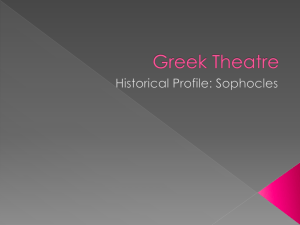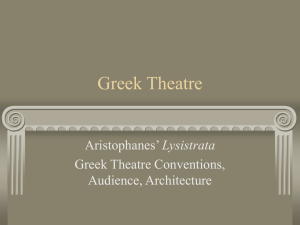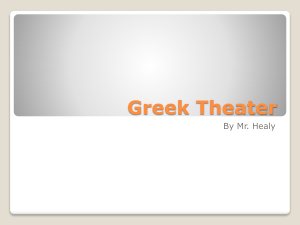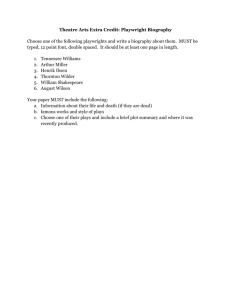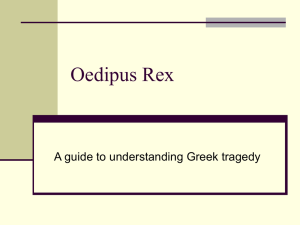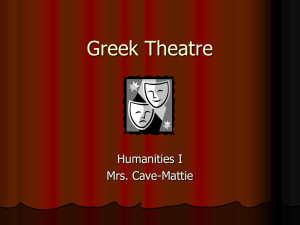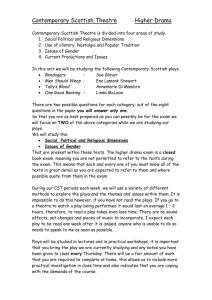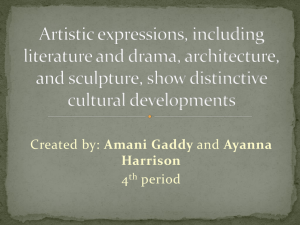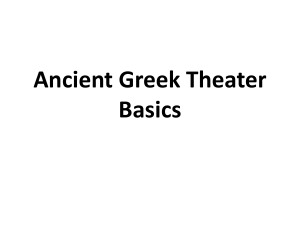Origins of Greek Theatre
advertisement
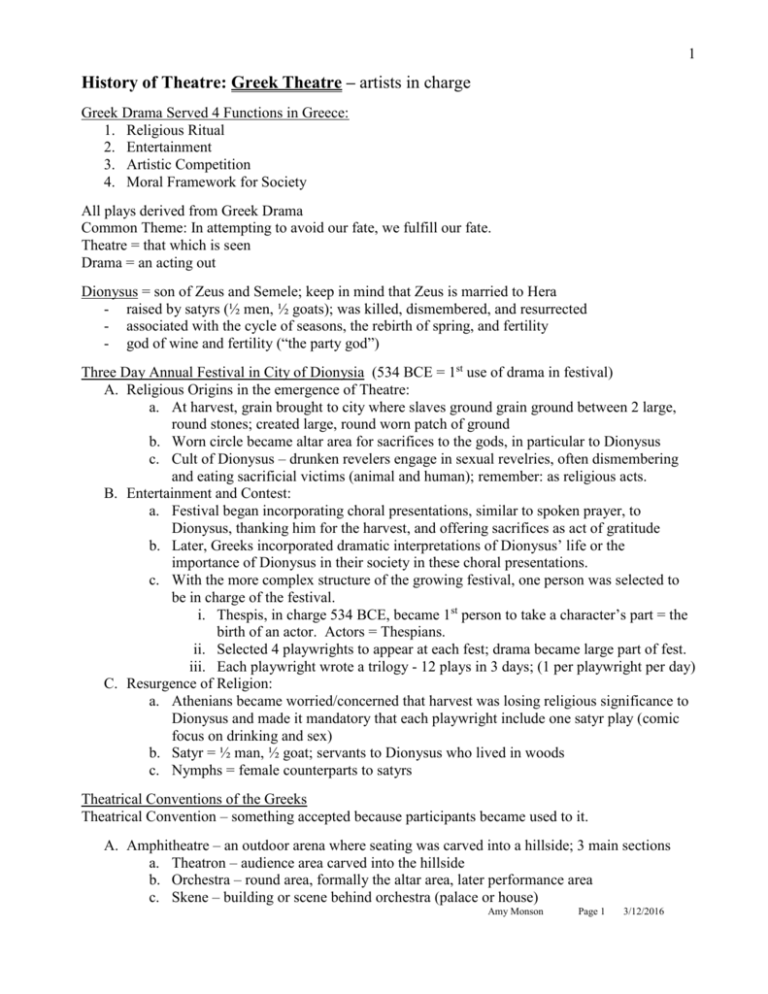
1 History of Theatre: Greek Theatre – artists in charge Greek Drama Served 4 Functions in Greece: 1. Religious Ritual 2. Entertainment 3. Artistic Competition 4. Moral Framework for Society All plays derived from Greek Drama Common Theme: In attempting to avoid our fate, we fulfill our fate. Theatre = that which is seen Drama = an acting out Dionysus = son of Zeus and Semele; keep in mind that Zeus is married to Hera - raised by satyrs (½ men, ½ goats); was killed, dismembered, and resurrected - associated with the cycle of seasons, the rebirth of spring, and fertility - god of wine and fertility (“the party god”) Three Day Annual Festival in City of Dionysia (534 BCE = 1st use of drama in festival) A. Religious Origins in the emergence of Theatre: a. At harvest, grain brought to city where slaves ground grain ground between 2 large, round stones; created large, round worn patch of ground b. Worn circle became altar area for sacrifices to the gods, in particular to Dionysus c. Cult of Dionysus – drunken revelers engage in sexual revelries, often dismembering and eating sacrificial victims (animal and human); remember: as religious acts. B. Entertainment and Contest: a. Festival began incorporating choral presentations, similar to spoken prayer, to Dionysus, thanking him for the harvest, and offering sacrifices as act of gratitude b. Later, Greeks incorporated dramatic interpretations of Dionysus’ life or the importance of Dionysus in their society in these choral presentations. c. With the more complex structure of the growing festival, one person was selected to be in charge of the festival. i. Thespis, in charge 534 BCE, became 1st person to take a character’s part = the birth of an actor. Actors = Thespians. ii. Selected 4 playwrights to appear at each fest; drama became large part of fest. iii. Each playwright wrote a trilogy - 12 plays in 3 days; (1 per playwright per day) C. Resurgence of Religion: a. Athenians became worried/concerned that harvest was losing religious significance to Dionysus and made it mandatory that each playwright include one satyr play (comic focus on drinking and sex) b. Satyr = ½ man, ½ goat; servants to Dionysus who lived in woods c. Nymphs = female counterparts to satyrs Theatrical Conventions of the Greeks Theatrical Convention – something accepted because participants became used to it. A. Amphitheatre – an outdoor arena where seating was carved into a hillside; 3 main sections a. Theatron – audience area carved into the hillside b. Orchestra – round area, formally the altar area, later performance area c. Skene – building or scene behind orchestra (palace or house) Amy Monson Page 1 3/12/2016 2 Theatrical Conventions of the Greeks (continued) B. Duex ex Machina: literally “god from the machine” a. Crane was used to fly actors (gods, supernatural beings) in and out of scenes, often to solve the problems of the characters. b. Offered a magical quality C. Chorus: Choral presentations evolved from religious rituals, maybe like choral readings; improvised story or traditional refrain sung or chanted in verse. a. Functions: i. Agent in play: gives advise, expresses opinions, asks questions, at times involved in action ii. Establishes ethical or social framework of the events and sets up a standard against which the action may be judged iii. Ideal spectator, reacting to events and characters as dramatist hopes audience would iv. Sets overall mood, heightens dramatic effects (like music does in a movie) v. Adds movement, spectacle, song and dance vi. Rhythmical function, time for the audience to reflect on the previous scene D. Costumes – to be seen and heard, to appear “larger than life” a. Large masks w/ built in megaphones (wood or paper machete) b. Elevated/platform shoes c. Padded shoulders on robes d. Extended arms, large gloves E. Musical Accompaniment: flute (oboe), lyre, trumpet, percussion Participants in Greek Theatre All actors and audience = Male. Must be a citizen (male), which was a position of status. Action Violence occurred offstage. Messengers (chorus, later individuals) delivered news of violence with gory details, though the imagination was often worse than what could be portrayed onstage. Greeks respected and admired playwrights - Evidence of lofty status in official records of sanction and financial support (c 6 BCE) - Granite statues in honor of playwrights - Numerous surviving amphitheatres; sometimes carvings of playwrights Aristotle’s Poetics – Unities of Time, Place, and Action - Real Time – no artificial lapses of time; no flashbacks - Single Setting – no jumping from place to place - Action must Flow – one event to another; tag team events occurring “off stage” with those on stage; causal relationship of the action Amy Monson Page 2 3/12/2016 3 “The Four-Most” Greek Playwrights 1. Aeschylus (523-456) 80 titles known, 7 survive; The Persians; The Seven Against Thebes; The Oresteia (containing a trilogy): Agamemnon, Libation Bearers, Eumenidies; Prometheus Bound. a. Introduced 2nd actor b. Used spectacle: large casts, chariots, horses, mythological characters, lavish costumes. c. Acted, choreographed, and taught chorus. 2. Sophocles (496-406) wrote approx. 120 plays, 7 survive: The Theban Plays: Oedipus Trilogy ( …Oedipus Rex, Oedipus at Colonus, Antigone); Ajax, Electra, Trachiniae, Philocletes. a. Introduced 3rd character b. Fixed a chorus size at 15 c. 1st to use scene painting d. Won 24 of the contests e. Major Theme: human tragedy f. Citizen, statesman, general, poet 3. Euripides (480-406) approx. 90 plays,18 survived: Alcestis, Medea, Hippolyus, The Children of Hercules, Andromache, Hecuba, Heracles, Ion, The Trojan Women, Electra, Iphigenia in Taurus, Helen, The Phoenician Women, Orestes, The Bacchae, Iphigenia at Aulis, Cyclops. a. Not popular – questioned traditional values and myths b. Accused of undermining the bases of society – Controversial 4. Aristophanes (448-380) 40 plays, 11 survive: Archarnians, Birds, Clouds, Wasp, Lysistrata, Knights, Peace, Frogs, Plutus, Thesmophoriazusae, Ecclesiazusae. a. Only surviving Greek comic author b. Commentary and satire on contemporary society, politics, and literature. Original Meaning of “Tragedy” unsure: 1. “goat song” – chorus perhaps danced for a prize of a goat 2. goat sacrificed as ritualistic worship to Dionysus 3. Aristotle’s POETICS says tragedy evolved from improvisations by leaders of dithyrambs (hymns sung and danced to honor Dionysus) 4. evolved from the rites of heroes’ tombs 5. satyr plays: burlesques of mythology Comedy - According to Aristotle, comedy developed from improvisations by leaders of phallic songs in fertility rites. Amy Monson Page 3 3/12/2016 4 History of Theatre: Roman Theatre -- popular people in charge I. Different From Greeks A. Built on Flat Ground instead of hillside (more slaves than Greeks to build seating) B. Elaborately Decorated C. Focal Point on high, elevated stage D. Disappearance of Chorus E. Vitruvious’ Ideal 12 Pointed Star 12 = magical number to Romans F. Renovated Greek theatres – cutting & paving orchestra - float ships for naval battles - study war, combat, & weapons - when Romans conquered others they absorbed their cultures into their own G. Almost all Roman plays were translations of Greek plays; few rare originals - “racier and more robust” - no tragedies performed; only comedies - lost mythical vitality; focused more on realistic portrayal II. Etruscan Influences A. Before 240 B.C.E. Etruria held sacred festivals that included acting, dancing, flute playing, juggling, prize fighting, horse racing, acrobatics, and competitive sports. (similar to our Saturday TV) B. 2 Historians credit Etruria as origin of Roman theatre. 1. Horace (65 - 8 B.C.E) wrote ARS POETICA = prescriptive manual of rules for playwrights. a. Latin drama originated from Fescennine Verses (short, improvised, often obscene dramatic sketches) b. Fescennium = town on the Etruscan border 2. Livy (59 BCE – CE 17) credits 364 BC when Etruscan musicians & dancers were imported to appease gods & end plague. III. Oscan Influences (4th century BCE) Attellan farce (improvised sketches with riddles & obscene sight gags) A. Possible source for Comedia Dell’arte (Italian Renaissance) B. Stock Characters with stock costumes & masks 1. Mandacus: a chewer, monster with great jaws 2. Pappus: a foolish old man 3. Maccus: fool, a stupid guzzler 4. Bucco: fool, a boastful buffoon 5. Dossenus: hunchback, wise fool Something about these characters makes us feel superior. Amy Monson Page 4 3/12/2016 5 IV. Roman Playwrights A. Titus Maccus Plautus (254-184 BCE) Falsely credited with 130 plays – POPULAR! 21 for certain still in existence All adapted from Greek new comedy, but “racier & more robust” THE MENECHMI – basis for Shakespeare’s “The Comedy of Errors” B. Caedilius Statius (219-168 BCE) transition from Plautus to Terance. 42 titles, no complete scripts. C. Publius Terentius (Terance) (185-160 BCE) – 6 plays, all still exist - Carthinian slave - more sophisticated than Plautus * began plot and sub-plot (contaminatio: combination of elements from several Gr. plays all put into one. ) F. Lucius Annacus Seneca (5 or 4 BCE- CE 65) - closet drama – translated Greeks tragedies, never performed by Romans - 9 plays, including Oedipus, Medea, Agamemnon - Nero’s Tutor, committed suicide after a falling out with Nero Even Nero knew secretly that there was artistic value in Greek tragedies, but he found them culturally invaluable to his brutal society because they preached morality. Fall of the Roman Empire. Middle Ages, Feudalism, Plagues } focus of civilizations becomes survival, not art Amy Monson Page 5 3/12/2016
